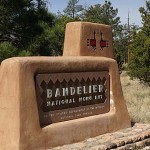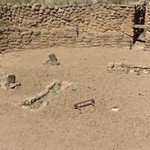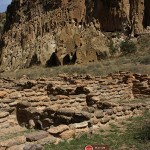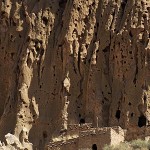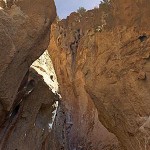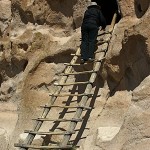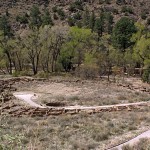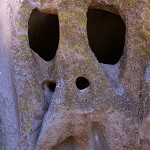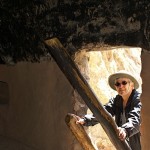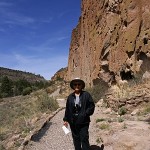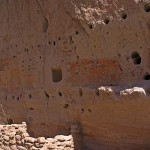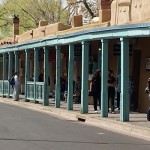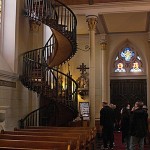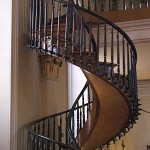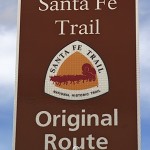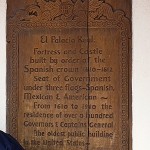[Note: Photos from today are in an image gallery at the end of the post.]
Our sleep last night was interrupted by the receipt of e-mails on our phones (and iPads) informing us that our house had lost utility power and our whole house generator had started and was running. As we learned later from studying the event log (using our Kohler OnCue software) the power had flickered several times, causing the genset to start and then stop, until the power finally failed (or was disconnected by the utility company) and stayed off, causing the genset to start (and stay on) and the transfer switch to shift the house from the utility lines to the genset until the utility power was eventually/finally restored. This, of course, is exactly what the generator and transfer switch are designed to do and the reason we have them installed.
We got up around 7 AM, left around 7:45 AM, and were kept abreast of the generator’s status as we drove. We headed east on I-40 as far as Moriarty and then headed north on NM-41 towards Santa Fe. Just before reaching the southern edge of the greater Santa Fe area NM-41 merged into US-285 north. We continued on US-285 well north of Santa Fe and then headed west on NM-502 towards Los Alamos, and the Los Alamos National Laboratory (LANL), before turning south on NM-4 towards Bandolier National Monument (BNM).
I visited BNM 26 years ago with our son but this was Linda’s first visit. BNM is remote but my recollection was that it was worth the drive and that proved to be the case. We had a couple of “conversations” with a female ranger (?) at the visitor center who had a rather annoying superior attitude, the first time in my 63 years that I have had a less that wonderful encounter with someone from the NPS, but we were there to see ruins and managed to get the information we were seeking.
LANL, the home of the atomic bomb and still the center for nuclear research in the U.S.A., is actually spread out over a vast, remote region northwest of Santa Fe. We saw a sign for a museum which we presume was in the town of Los Alamos, but did not check it out. Museums take a lot of time to see and usually involve an admission fee, which is all the more reason to spend the necessary time to tour them properly.
Albuquerque and Santa Fe have a least a dozen fabulous museums between them, maybe each, and we would need to spend 3 – 4 weeks camped somewhere between the two cities, or two weeks in one and two weeks in the other, to visit most of them and not be exhausted by the time we were done. We are actually making our way towards home and only spending a few days in the area to get a sense of the place and visit a few places. Full- and extended-time RVing are NOT full- or extended-time vacationing. If we approached what we are doing with the attitude that we had to see everything everywhere we went, and do so in the limited amount of time available, we would quickly be broke and exhausted. We plan to be back this way in the future and will have a better idea of what we want to see and do when we return.
We left BNM and returned to Santa Fe by reversing our route. We navigated to Old Town and found ourselves in heavy traffic on narrow streets looking for a place to park. Our tour guide map of the area showed public parking but we drove past those locations without seeing the referenced space. We did see several parking garages, but I had the ham radio antenna on the roof of the car and could not pull in. We finally spotted a parking space along a small park area at the northeast corner of Old Town and parked there at no charge. Almost all of the parking in Santa Fe involves parking meters or pay lots but we did not have any change with us, so if we had not spotted this parking space we would not have stopped to see Old Town.
We were glad, however, to find this parking spot as it was a short walk to Old Town which is a fairly compact/dense area. Our first stop was the Loretto Chapel with its famous spiral staircase. The staircase is a 23 foot high double helix that makes two 360 degree twists from the floor to the choir loft. It does not have a center column and was originally supported only at the top and bottom, although several “supports” have been added to stabilize it against the vibrations of modern vehicular traffic. The choir loft was originally accessed by ladders but when the church became the chapel for a girls’ school run by the Sisters of Loretto the ladders were not considered appropriate.
The story behind this staircase is that the Sister’s prayed a novena to St. Joseph, the patron saint of carpenters, for a staircase to the choir loft. The chapel is small and any conventional staircase would have taken up too much space. A carpenter appeared not long after the novena and built the staircase using only simple hand tools. He did not give the sisters his name or ask for any compensation. He left without any indication of where he came from or where he was headed and was never seen or heard from again.
Given the mystery of this event, some came to believe that the carpenter was St. Joseph himself. Of more interest to architectural scholars is the engineering “mystery” of how the staircase was constructed. It was unclear from our visit whether the carpenter worked in secrecy, but whether he did or not the Sisters apparently did not make/keep any record of the details of the work. As originally constructed the staircase had an inside railing but no outside railing, which would certainly have lightened its visual and actual weight and made for a rather interesting climb. (The outside railing was added many years later but does not add anything structural to the staircase.) The treads and risers are all connected on the inside and outside edges so the staircase is a continuous spiral which is an inherently strong shape. Indeed the double helix shape of the staircase is the same shape as strands of DNA, discovered over 100 years after its construction. The more practical problem for me turned out to be the difficulty of photographing it as the chapel is small and dim but has very bright stained glass windows. BTW: the chapel is now privately owned and admission is $3 per person.
From the chapel we walked back to the central plaza. The north side of the plaza is the Palace of the Governors. Originally built in 1610-1612 it was the seat of Spanish government in this area. It was then the seat of Mexican government here and finally the government of the United States of America. It has the distinction of being the oldest, and longest continuously occupied, government/public building in the U.S.A., although it now houses a history museum. Also of interest is the covered sidewalk that runs the entire length of the building. It was packed from one end to the other with Native Americans selling their jewelry and other craft items. We read later that this has been going on for a very long time. In spite of all of the art galleries, jewelry stores, and boutiques in Old Town Santa Fe I would probably buy something from one of the Native sellers if I was in the market for these kinds of items.
We were not here to shop, however, and had not had lunch so having had a look at the place we put the address for the Thai Vegan restaurant in the GPS and headed south on Cerrillos Road (NM-14) in search of dinner. Thai Vegan was the top rated vegan restaurant in the Santa Fe area on Happy Cow. We arrived at 4:25 PM and discovered that they were closed from 3 – 5 PM. No problem; we just sat in the parking lot and waited. Vegan restaurants are not (yet) common and after two fairly long, active days of sightseeing Linda was looking forward to not cooking dinner tonight. The service was friendly and the food was OK; not the best vegan restaurant food we’ve ever had, but good enough. They make their own vegan “ice cream” and it was very good. I had coconut and Linda had green tea.
We were done with dinner by 6:15 PM and sunset was not until 7:30 PM so we drove home on NM-14, the Turquoise Trail, through Madrid and other small towns on the eastern foothills of the Sandia Mountains. It was a beautiful and fun drive and we got back to our coach almost exactly 12 hours from when we left this morning.
Most of the shops in Madrid were closed but the bars and restaurants were open. It is an old mining town that became a ghost town, got re-discovered in the 1970s, and became an artists’ colony. Many of the old mining shacks have been reclaimed and turned into homes. The town has a rough, funky appearance and we would like to return sometime during the day to check out the shops and galleries. But not on this trip. We have some long driving days ahead of us and would like to have a day to clean the coach, recharge the water softener, and relax. For Linda that means online word games and looking at her new Vegetarian Southwest cookbook. For me that means working on our website/blog.
- Entrance sign for Bandolier National Monument, the end of a 94 mile, 2-1/2 hour drive.
- A panoramic photo of the largest, most visible, and most excavated Kiva at BNM.
- The Ancient Puebloan culture that inhabited this valley built both on the valley floor foreground) and in the cliffs (behind).
- The rock in the canyon walls at BNM is relatively softer and porous making it a little eaiser to enlarge natural openings into usable size room.
- A vertical panorama looking into one of the narrow side canyons at BNM.
- Linda does not like ladders as a general rule but she was not going to miss out on seeing inside the cliff dwelling room.
- Looking back (south) towards the main Pueblo on the valley floor from the cliff dwelling trail.
- There was no information as to whether these openings were natural or man-made but either way the ancient inhabitants surely would have seen this as a face just as we do today.
- Visitors are allowed to climb up to this cliff room and go in. Linda came up the ladder far enough to have a good look.
- Linda on the cliff dwelling trail at BNM with her Tilley Hat, binoculars, and trail guide.
- The small, regularly spaced, holes were carved to support the ends of tree trunks used as roof beams. The darker patch was a pictograph that had been covered over but later discovered by archeologists.
- Much of Old Town Santa Fe looks like this. The appearance masks the very upscale (expensive) art and jewelry businesses that predominate Old Town.
- The famous spiral staircase in the Loretto Chapel, Santa Fe, New Mexico.
- A slightly closer view of the Loretto Chapel spiral staircase. The outside railing is not original and was added many years later.
- We were on and off Historic Route 66 near Albuquerque, but we ended up on the Santa Fe Trail in … Santa Fe, New Mexico.
- This wooden plaque explains about the Palace of the Governers, which is now a museum.
.
